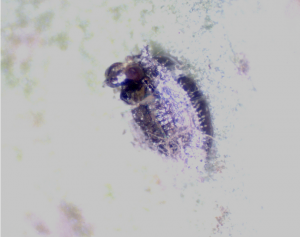Whiteflies, of the family Aleyrudidae, are insects that belong to the same order as Aphids, Hemiptera. These small bugs are about 1-2mm long in adult form, with two pairs of white wings. Most of their time is spent on the underside of leaves, using their piercing mouth-parts to suck up phloem sap and it is here that they lay their eggs in high quantities. Across the world they’ve played a role in the ongoing struggle against crop losses by being great vectors of plant disease.
In terms of development, growth to adulthood takes roughly a month. Crawlers emerge from the eggs and move a short distance before settling to feed. They will then stay stationary, feeding on the plant through four stages of development, although this may vary between species. After about a month adults will exit the nymph body through a t-shaped cut.
You may notice that in the bottom left of the above image, one of the blobs (whitefly nymphs) is black. Well this is not in fact a healthy whitefly nymph at all but the remains of it’s body with a minute wasp living and growing inside it.
The term parasitoid means something that benefits to the detrimental effect of a host, ultimately resulting in that hosts death. Living up to the hype, the young of this particular parasitoid wasp consume their host from the inside, giving them energy to grow and develop.
When thinking about wasps most people would probably mention a sting as their most defining characteristic. A wasps sting is in fact the adapted form of an organ known as an ovipositer, which some organisms possess and use to place eggs. Wasps are a group of organisms that use the ovipositer highly effectively, something that has allowed them to radiate in to a variety of niches.
In nature we can observe how the ovipositers of different wasp species have evolved to serve different purposes. Some drill through wood, placing eggs safely within a tree trunk. Others have developed effective poison glands to subdue prey or act as a defensive measure, resulting in the sting with which we’re all so familiar. Parasitoids in particular use their ovipositer to inject eggs in to or on a suitable host. The eggs may be accompanied by toxins to subdue the host or specific polydnaviruses that have evolved with the wasp to disable a hosts immune system, therefore allowing development to adulthood without attack.
The whole situation sounds very alienesque and you can see how Ridley Scott may have taken inspiration from nature in his alien series of films. Although we know that the fictional species in the films is definitely an alien, we can find a lot of the key ideas that make up the monster in nature. Take for example the initial parasitoid lifestyle resulting in a rather uncomfortable exit. Or maybe the unnatural double sets of jaws also held by the moray eel. Or even the ovipositer that the alien queen in aliens uses to lay eggs.
I suppose the acid blood may take a little explaining though…







Actually, formic acid was in fact first synthesized by humans using ants, where it naturally occurs! Hence why it’s name is derived from the family to which ants belong: Formicidae.